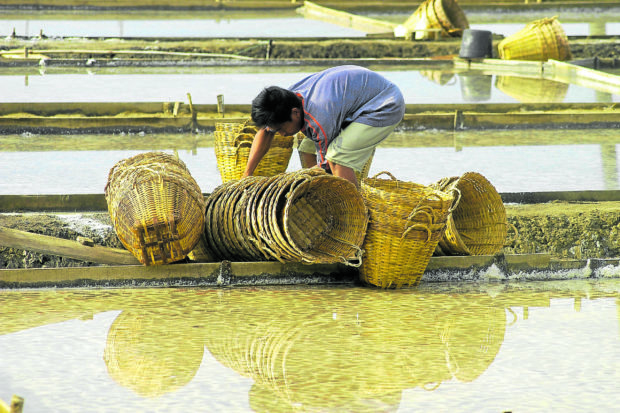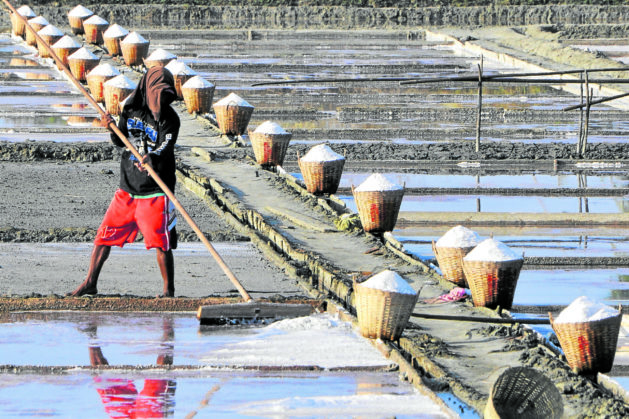Ilocos salt industry losing its savor

LOSING OUT TO IMPORTS In this file photo, a worker on a salt farm in Alaminos City in Pangasinan province prepares the “kaing” (bamboo hamper) to haul the next batch of harvest from the community’s salt beds. Owners and workers of salt farms in the Ilocos region are seeking government help to save the ailing industry, especially with the bulk of the country’s supply coming from foreign producers. —PHOTO BY WILLIE LOMIBAO
SAN FERNANDO CITY, Pampanga, Philippines — Rene Aruelo, 52, was in his teens in the 1980s when he would rake mud at a fishpond in a village in La Union province facing the Lingayen Gulf.
His family, like most households in their community, would troop to the pond fed by saltwater from the nearby sea at Barangay Ubagan in Sto. Tomas town.
The pond owner allowed residents to scrape the cracked mud every day during the dry season so they can produce salt.
“We start scraping the mud early in the morning, turning them again at noontime to dry them more, and gathering them in the afternoon,” Aruelo told the Inquirer.
But that was just the beginning of the backbreaking work to produce salt.
Article continues after this advertisement“We filtered the mud through husk and sand, collecting the brine solution in large earthen jars. If a vial with a pebble inside could float in the brine, it’s ready for cooking,” he recalled.
Article continues after this advertisementHe added: “For two to three hours straight, we cooked the brine until it turned into wispy white salt.”
But the community-based salt production came to a halt when a state university bought the fishpond in the area and barred residents from extracting the mineral from the ponds.
Although salt making was just a small-scale industry in the Ilocos region, it had contributed to the country’s self-sufficiency in salt in the past, according to the workers.
Pangasinan production
In nearby Pangasinan province, the towns of Dasol and Bolinao are known to be major producers of salt. Pangasinan, in fact, owes its name to the mineral as it translates to “where salt is made.”
From March to May, workers in Dasol and Bolinao would be seen raking salt from tile-lined beds called “banigan.”
They would shovel the crystals into the “kaing” (a hamper made of bamboo) hooked to bamboo poles, and lug these to the stockyard.

BACKBREAKING JOB Producing salt is no easy job, with workers, like this man in Dasol town in Pangasinan, spending long hours tending the salt beds, locally known as “banigan.” Salt crystals are collected and manually shoveled into large bamboo baskets and taken to a stockyard before these are cooked and processed. PHOTO BY WILLIE LOMIBAO
Commercial farming
Workers in Pacific Farms Inc. (PFI), a commercial salt farm in Bolinao, also harvest salt from sprawling salt beds in the town.
But unlike in Dasol where manual labor is still common practice, Bolinao workers use machines to scrape the bottom of ponds. They would then transport the muddy crystals through carriages that pass through a rail track straight to the washing area, where a machine using brine water removes the mud from the salt crystals.
PFI, the country’s largest commercial farm, uses different technologies to hasten the evaporation of water and speed salt crystallization, such as increasing the temperature at the salt beds through solar heaters and solar coils.
Dasol’s salt farms have about 10,000 banigan found in 11 villages that produce 18,000 metric tons of salt every year.
PFI alone churns up to 25,000 MT a year from its 473-hectare farm.
But their total production hardly makes a dent in the country’s requirement for salt, which is 600,000 MT a year.
Gerald Khonghun, PFI’s operations manager, said the country used to be self-sufficient in salt 40 years ago.
“But now we are importing 91 to 93 percent of our requirements and we are currently importing 550,000 MT a year,” Khonghun told the Inquirer.
Citing data from the Philippine Statistics Authority, Khonghun said the country imports 70 percent of the local salt requirement from Australia (446,000 MT) and 20 percent (87,000 MT) from China.
The country would need more salt soon because the coconut industry will require 300,000 MT to fertilize 300,000 coconut trees, at 1 kilo a year per tree.
“The total requirement would eventually be 850,000 tons, worth $42 million,” he said.
But PFI’s production has to be stopped soon following the takeover by the Department of Environment and Natural Resources (DENR) of the company in February.
PFI’s foreshore lease contract had expired on June 22, 2002, or 19 years ago.
Several billboards announcing the takeover are placed in different parts of the farm, but salt production continues, with the PFI management asking to complete the salt harvest until June.
The sale would pay for the workers’ wages, said Khonghun’s father, Johnny, PFI’s chief executive officer.
The DENR’s takeover of PFI came at a time when the government was finally recognizing the importance of the salt industry, and the need to put it under an agency dedicated to its production and management.
Pangasinan Rep. Ramon Guico III and Ilocos Sur Rep. Deogracias Victor Savellano filed separate resolutions to help the salt industry and its workers.
Savellano filed House Resolution No. 1046 in July 2020 asking various government agencies that provide benefits to fisherfolk to also extend assistance to salt producers, as both are economically linked.
Guico, on the other hand, filed HR 1032 asking the Department of Agriculture (DA) and the Department of Science and Technology to provide the needed technology upgrade for salt producers in northern Luzon, as they are part of the fisherfolk sector.
Guico said he was also filing a bill that would create a center to oversee the salt industry.
“We have the agencies that manage different commodities like sugar, tobacco, carabao, fisheries and others. But we do not have [an] agency for salt, which is an important product not only for food but for many sectors. So why shouldn’t there be an agency that would manage the salt industry?” he said.
The Bureau of Fisheries and Aquatic Resources (BFAR) has been tasked to formulate a road map to put the salt industry on the right track.
During a meeting in March in Bolinao, Nestor Domenden, DA regional director, announced that P100 million was earmarked by the national government to craft the plan for the Ilocos, one of the top salt producers in the country.
Prime commodity
“Salt is a prime commodity. Without it, we will have no bagoong (fish paste), no ‘patis’ (fish sauce). If the local industry dies, we will have to import again, like what we are doing with bangus fry, which we import a big bulk of our need,” Domenden said.
He added: “A problem would arise if the countries from where we import change their policy and won’t sell salt to us anymore. What will we do then?”
Domenden said programs and projects that would be implemented must benefit both farmers and salt workers.
Segundina Rosario Gaerlan, BFAR Ilocos officer in charge, said she was happy that her agency was given the important task to chart the future of the local salt industry.
The initial projects are focused on small-scale salt production, helping the producers to have better storage, hygienic handling, marketing and even laboratory tests, she said.
Gaerlan also said that the Pangasinan State University had proposed to establish the Asin (Advanced Salt Innovation) Center to help the industry and its workers.
According to Gaerlan, it is ironic that the country has to import salt when it has a long coastline where salt can be produced.
Long shoreline
The younger Khonghun said the country’s shoreline spans 36,000 kilometers and salt could easily be produced even if the government would tap only 69 km of this span.
“The Ilocos region alone has 845 km of shoreline, and only 8 percent of that would make us self-sufficient,” he said.
“Producing what the country needs would involve only 12,000 to 13,000 ha of shoreline and the technology is available, very economically and sustainably. The PFI has the technology and we want to share that,” said Khonghun, who had trained in China on salt farm operation and salt production.
Salt, he said, has 14,000 uses in food, agriculture, chemical, pharmaceutical and manufacturing industries.
“You need salt production. Self-sufficiency in salt will contribute to the industrialization of the Philippines. It is a natural food security issue. If we do not have salt, the Philippines is vulnerable to a full supply chain crisis,” Khonghun said.